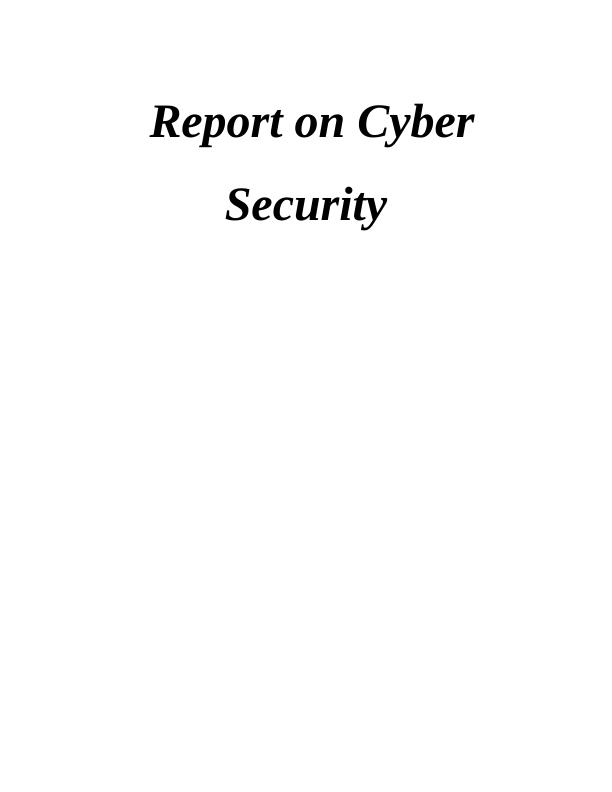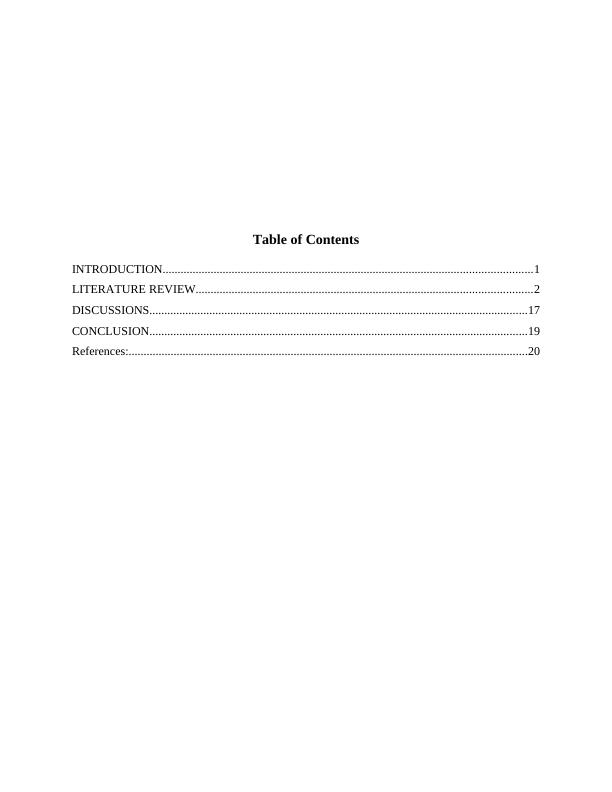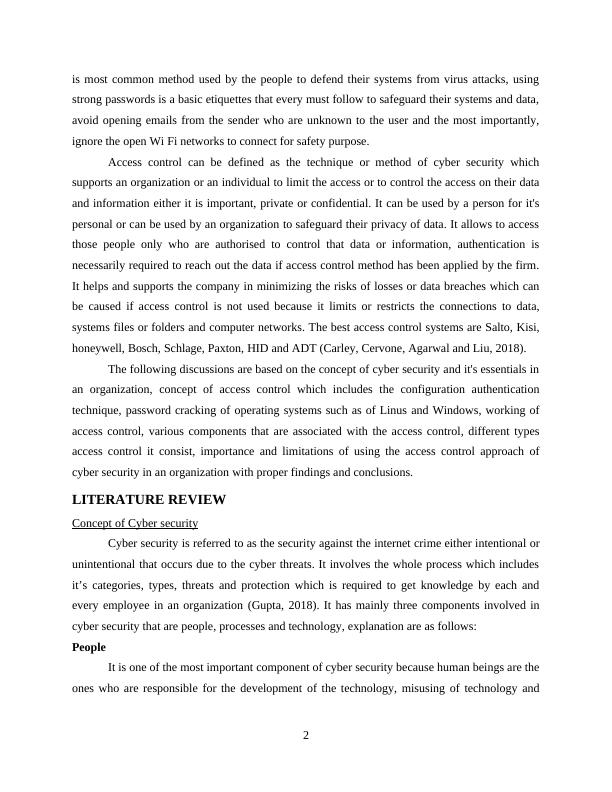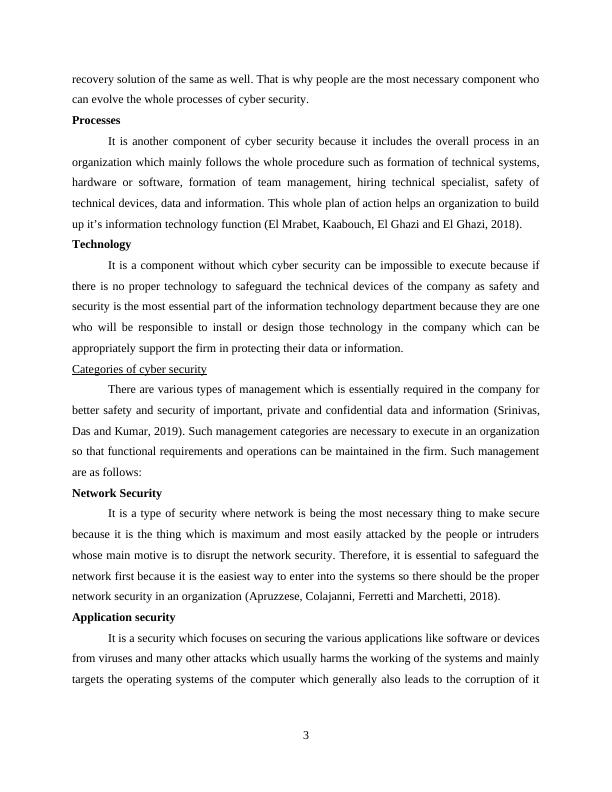Understanding Access Control in Cyber Security
Added on 2022-12-29
24 Pages9360 Words80 Views
Report on Cyber
Security
Security

Table of Contents
INTRODUCTION...........................................................................................................................1
LITERATURE REVIEW................................................................................................................2
DISCUSSIONS..............................................................................................................................17
CONCLUSION..............................................................................................................................19
References:.....................................................................................................................................20
INTRODUCTION...........................................................................................................................1
LITERATURE REVIEW................................................................................................................2
DISCUSSIONS..............................................................................................................................17
CONCLUSION..............................................................................................................................19
References:.....................................................................................................................................20


INTRODUCTION
Research topic: To understand the concept of access control on cyber security in an
organization
Research aim: To investigate about the principles of access control and it's emphasis on cyber
security in an organization
Research objectives:
To analyse the concept of cyber security and it's effect on IT function in an organization
To examine the consequences of requirements and recovery solutions given by cyber
security on the working of an organization
To determine the effect of the concept of access control on the organizational
performance
To identify the impact of working, components and types of access control on the
organizational operations
To observe the outcome of relationship between the cyber security and access control on
the organizational management
To study about the importance and limitations of using access control in an organization
Research background:
Cyber security can be defined as the prevention of the technical devices such as hardware
and software from unusual attacks from hackers. In other words, it is also known as electronic
information security or information technology security. It saves the network, computers,
servers, mobile devices, electronic systems and data from malicious attacks. It provides
securities in various forms such as network security, application security, information security,
operational security, disaster recovery, business continuity and end user education (Sun, Hahn
and Liu, 2018).
There are various types of cyber threats involved in it such as cyber crime, cyber attack
and cyber terrorism which uses different methods to attack such as using malware, viruses,
trojans, spyware, ransomware, adware, botnets, SQL injection, phishing, man in the middle
attack, denial of service attack, dridex malware, romance scams and emotet malware.
Therefore, in accordance of it, there are various safety tips are also provided from the end
user protection side such as frequently updating the software and operating system whenever it
feels that system is not working properly or automatically in some time, using anti virus software
1
Research topic: To understand the concept of access control on cyber security in an
organization
Research aim: To investigate about the principles of access control and it's emphasis on cyber
security in an organization
Research objectives:
To analyse the concept of cyber security and it's effect on IT function in an organization
To examine the consequences of requirements and recovery solutions given by cyber
security on the working of an organization
To determine the effect of the concept of access control on the organizational
performance
To identify the impact of working, components and types of access control on the
organizational operations
To observe the outcome of relationship between the cyber security and access control on
the organizational management
To study about the importance and limitations of using access control in an organization
Research background:
Cyber security can be defined as the prevention of the technical devices such as hardware
and software from unusual attacks from hackers. In other words, it is also known as electronic
information security or information technology security. It saves the network, computers,
servers, mobile devices, electronic systems and data from malicious attacks. It provides
securities in various forms such as network security, application security, information security,
operational security, disaster recovery, business continuity and end user education (Sun, Hahn
and Liu, 2018).
There are various types of cyber threats involved in it such as cyber crime, cyber attack
and cyber terrorism which uses different methods to attack such as using malware, viruses,
trojans, spyware, ransomware, adware, botnets, SQL injection, phishing, man in the middle
attack, denial of service attack, dridex malware, romance scams and emotet malware.
Therefore, in accordance of it, there are various safety tips are also provided from the end
user protection side such as frequently updating the software and operating system whenever it
feels that system is not working properly or automatically in some time, using anti virus software
1

is most common method used by the people to defend their systems from virus attacks, using
strong passwords is a basic etiquettes that every must follow to safeguard their systems and data,
avoid opening emails from the sender who are unknown to the user and the most importantly,
ignore the open Wi Fi networks to connect for safety purpose.
Access control can be defined as the technique or method of cyber security which
supports an organization or an individual to limit the access or to control the access on their data
and information either it is important, private or confidential. It can be used by a person for it's
personal or can be used by an organization to safeguard their privacy of data. It allows to access
those people only who are authorised to control that data or information, authentication is
necessarily required to reach out the data if access control method has been applied by the firm.
It helps and supports the company in minimizing the risks of losses or data breaches which can
be caused if access control is not used because it limits or restricts the connections to data,
systems files or folders and computer networks. The best access control systems are Salto, Kisi,
honeywell, Bosch, Schlage, Paxton, HID and ADT (Carley, Cervone, Agarwal and Liu, 2018).
The following discussions are based on the concept of cyber security and it's essentials in
an organization, concept of access control which includes the configuration authentication
technique, password cracking of operating systems such as of Linus and Windows, working of
access control, various components that are associated with the access control, different types
access control it consist, importance and limitations of using the access control approach of
cyber security in an organization with proper findings and conclusions.
LITERATURE REVIEW
Concept of Cyber security
Cyber security is referred to as the security against the internet crime either intentional or
unintentional that occurs due to the cyber threats. It involves the whole process which includes
it’s categories, types, threats and protection which is required to get knowledge by each and
every employee in an organization (Gupta, 2018). It has mainly three components involved in
cyber security that are people, processes and technology, explanation are as follows:
People
It is one of the most important component of cyber security because human beings are the
ones who are responsible for the development of the technology, misusing of technology and
2
strong passwords is a basic etiquettes that every must follow to safeguard their systems and data,
avoid opening emails from the sender who are unknown to the user and the most importantly,
ignore the open Wi Fi networks to connect for safety purpose.
Access control can be defined as the technique or method of cyber security which
supports an organization or an individual to limit the access or to control the access on their data
and information either it is important, private or confidential. It can be used by a person for it's
personal or can be used by an organization to safeguard their privacy of data. It allows to access
those people only who are authorised to control that data or information, authentication is
necessarily required to reach out the data if access control method has been applied by the firm.
It helps and supports the company in minimizing the risks of losses or data breaches which can
be caused if access control is not used because it limits or restricts the connections to data,
systems files or folders and computer networks. The best access control systems are Salto, Kisi,
honeywell, Bosch, Schlage, Paxton, HID and ADT (Carley, Cervone, Agarwal and Liu, 2018).
The following discussions are based on the concept of cyber security and it's essentials in
an organization, concept of access control which includes the configuration authentication
technique, password cracking of operating systems such as of Linus and Windows, working of
access control, various components that are associated with the access control, different types
access control it consist, importance and limitations of using the access control approach of
cyber security in an organization with proper findings and conclusions.
LITERATURE REVIEW
Concept of Cyber security
Cyber security is referred to as the security against the internet crime either intentional or
unintentional that occurs due to the cyber threats. It involves the whole process which includes
it’s categories, types, threats and protection which is required to get knowledge by each and
every employee in an organization (Gupta, 2018). It has mainly three components involved in
cyber security that are people, processes and technology, explanation are as follows:
People
It is one of the most important component of cyber security because human beings are the
ones who are responsible for the development of the technology, misusing of technology and
2

recovery solution of the same as well. That is why people are the most necessary component who
can evolve the whole processes of cyber security.
Processes
It is another component of cyber security because it includes the overall process in an
organization which mainly follows the whole procedure such as formation of technical systems,
hardware or software, formation of team management, hiring technical specialist, safety of
technical devices, data and information. This whole plan of action helps an organization to build
up it’s information technology function (El Mrabet, Kaabouch, El Ghazi and El Ghazi, 2018).
Technology
It is a component without which cyber security can be impossible to execute because if
there is no proper technology to safeguard the technical devices of the company as safety and
security is the most essential part of the information technology department because they are one
who will be responsible to install or design those technology in the company which can be
appropriately support the firm in protecting their data or information.
Categories of cyber security
There are various types of management which is essentially required in the company for
better safety and security of important, private and confidential data and information (Srinivas,
Das and Kumar, 2019). Such management categories are necessary to execute in an organization
so that functional requirements and operations can be maintained in the firm. Such management
are as follows:
Network Security
It is a type of security where network is being the most necessary thing to make secure
because it is the thing which is maximum and most easily attacked by the people or intruders
whose main motive is to disrupt the network security. Therefore, it is essential to safeguard the
network first because it is the easiest way to enter into the systems so there should be the proper
network security in an organization (Apruzzese, Colajanni, Ferretti and Marchetti, 2018).
Application security
It is a security which focuses on securing the various applications like software or devices
from viruses and many other attacks which usually harms the working of the systems and mainly
targets the operating systems of the computer which generally also leads to the corruption of it
3
can evolve the whole processes of cyber security.
Processes
It is another component of cyber security because it includes the overall process in an
organization which mainly follows the whole procedure such as formation of technical systems,
hardware or software, formation of team management, hiring technical specialist, safety of
technical devices, data and information. This whole plan of action helps an organization to build
up it’s information technology function (El Mrabet, Kaabouch, El Ghazi and El Ghazi, 2018).
Technology
It is a component without which cyber security can be impossible to execute because if
there is no proper technology to safeguard the technical devices of the company as safety and
security is the most essential part of the information technology department because they are one
who will be responsible to install or design those technology in the company which can be
appropriately support the firm in protecting their data or information.
Categories of cyber security
There are various types of management which is essentially required in the company for
better safety and security of important, private and confidential data and information (Srinivas,
Das and Kumar, 2019). Such management categories are necessary to execute in an organization
so that functional requirements and operations can be maintained in the firm. Such management
are as follows:
Network Security
It is a type of security where network is being the most necessary thing to make secure
because it is the thing which is maximum and most easily attacked by the people or intruders
whose main motive is to disrupt the network security. Therefore, it is essential to safeguard the
network first because it is the easiest way to enter into the systems so there should be the proper
network security in an organization (Apruzzese, Colajanni, Ferretti and Marchetti, 2018).
Application security
It is a security which focuses on securing the various applications like software or devices
from viruses and many other attacks which usually harms the working of the systems and mainly
targets the operating systems of the computer which generally also leads to the corruption of it
3

End of preview
Want to access all the pages? Upload your documents or become a member.
Related Documents
Cyber Security and IT Infrastructure: Challenges and Solutionslg...
|4
|723
|396
IT Security: Types of Risks, Organizational Procedures, Impact of Firewall Configuration, Implementation of DMZ, Static IP and NATlg...
|18
|1181
|61
Malware Attack and Malware Analysis: A Researchlg...
|9
|2293
|146
Malicious Software Protection Policylg...
|6
|1728
|181
Network Security and Types of Security Threats and Attacks in Information Technologylg...
|8
|2577
|274
Understanding SQL Injection, Insider Attacks, and Malware Threats for Enhanced Cybersecuritylg...
|7
|2711
|157
